Airport Food Round-Up – HKG, PEK, ICN
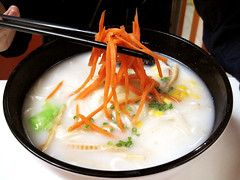 |
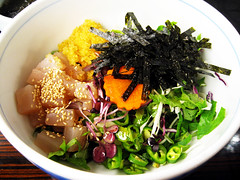 |
 |
 |
For those wondering if the end was nigh, well, it’s here. Until my next trip to Asia, this will be my last East Asian post, and it’s about airport food. Hell what?! Hell yeah, airport food! In East Asia, specifically in Beijing, Incheon, and Hong Kong, unlike here in the States, airport food is actually good. I ate roast goose, hwedupbab (회덥밥, similar to bibimbab, but with raw fish), and hot noodle soup; all within fifteen minutes of my departure gate. Not a single overpriced shrink-wrapped sandwich, stale bagel, or a generic hamburger was eaten.
The roast goose, of course, was in Hong Kong. Few days prior, I had some pretty disappointing roast goose at Yung Kee (average and boring), so unsated, I ordered roast goose with hot noodle soup (HK $88/US $11.35) at King’s Palace Congee & Noodle, which by the way had roast goose and barbecued pork hanging at the back of the counters. (Love it!) I wasn’t expecting much, it was the airport after all, but the goose was amazing. The meat was tender and flavorful, and the skin was luxuriously fatty with just enough crispness. It came with plum sauce, as did the roast goose at Yung Kee, but glazed in a sweet sauce, it didn’t need it all. It was pricey for airport food, but considering the goose at Yung Kee was around the same price and half as good, it was well worth it.
The noodle soup, however, was average. The rice noodles were a little short and a bit too al dente, and the soup had a strong seafood stench that was at first off-putting. After getting used to it though, it was quite enjoyable. Whatever they put in the stock to make it reek, also made the soup extremely flavorful. But most of all, I liked that the noodle soup was hot. I still never get why soup in the States is always served luke-warm. I don’t like to drink anything that reminds me tepid bath water.
At the food court in Incheon Airport, I had hwedupbab. Imagine, raw fish at the airport that’s actually good! Besides fish, there was also spicy peppers, garlic, kim (seaweed), lettuce, red cabbage, and a generous scoop of fish roe. Rice, gochujang, and meyeokguk (미역국, seaweed soup) was served on the side. At first, I took out the raw garlic because I didn’t want killer breath all day, but then I decided, ‘What the hell, this is Korea, let me live it up!’ And guess what, raw garlic in bibimbap makes a world of difference. It definitely gave the hwedupbab the fresh spicy kick it needed. It was lovely, my breath afterwards, not so much.
David had a regular bibimbab with the typical ingredients: bean sprouts, lettuce, red cabbage, doraji (도라지, bell flower root), gosari (고사리, fiddlehead ferns), pickled radish, and kim. The total for both of our dishes came out to ₩15,455 (US $13.73). Fresh, delicious, and cheap; it was my kind of meal.
Later near the gate, David wanted a coffee and we stopped by Dunkin’ Donuts. There, I saw the most curious looking thing, a kimchi doughnut (KR ₩1,300/US $1.16) . Without a second thought, I got one. The verdict: not as weird as I thought. It’s your basic fried Korean korokke (고로케, croquette) found in most Korean bakeries, but filled with kimchi and not as greasy. (Strangely, Dunkin’ Donuts makes a less greasy korokke. Why? It’s beyond me.) It was quite tasty, and according to the signage in the store, the kimchi doughnut is good for you. The kimchi doughnut supposedly contains vitamins A, B, C, and lactic acid bacteria (the good bacteria also found in yogurt). I wouldn’t go so far as calling anything from Dunkin’ Donuts healthy, but snackable?, unequivocally yes.
In Beijing, our last meal was at My Mill, a noodle soup shop. I ordered a chicken noodle soup that was pretty satisfying. Unfortunately, the chicken wasn’t fall-off-the-bone and the chili oil was very mild, but the noodles were chewy and the soup had a nice body.
David had a vegetable noodle soup. His soup was a bit thinner than mine, but overall, it was simple and good.
Accompanying the noodle soup was an assortment of pickled vegetables. It was nice to have on the side, but I wasn’t a big fan of any of them. Sour, but lacking zip, the plate functioned best as a colorful centerpiece.
Needing something sweet, as usual, David also ordered an ice cream soda. We both could have passed on this one. It was cola with a scoop of fake ice cream. Imagine the lowest quality ice cream possible, and this was it. It was ghastly; almost as bad as the ice cream we had the night before at a café in the Sanlitun Bar district. China may have perfected the noodle, but it’ll take a few more centuries to get the ice cream right. Stick to the noodles at My Mill and leave on a good note. Fortunately, our experiment into the unknown wasn’t too costly. Two bowls of noodle soup and one ice cream soda was ¥79 RMB (US $11.58).
With all the delays and cancellations these days, traveling isn’t as glamorous as it used to be. In fact, it pretty much sucks. But it’s comforting to know at some airports, they’re not trying to completely screw you over. Not all the way at least.
King’s Palace Congee & Noodle
Hong Kong International Airport
Departures East Hall, Level 7
(852) 2385-9969
Incheon International Airport
Passenger Terminal, 4F, East Side
(32) 743-3085
My Mill
Beijing Capital International Airport
T3 Terminal B1, 2-4 F
(10) 6455-8308






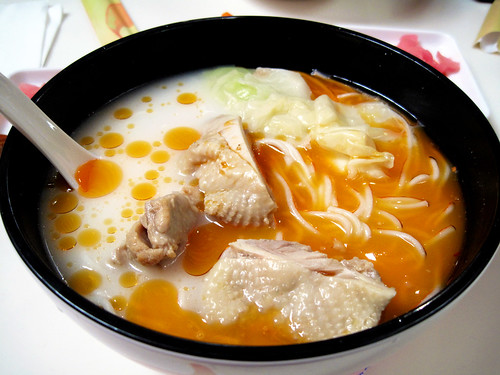
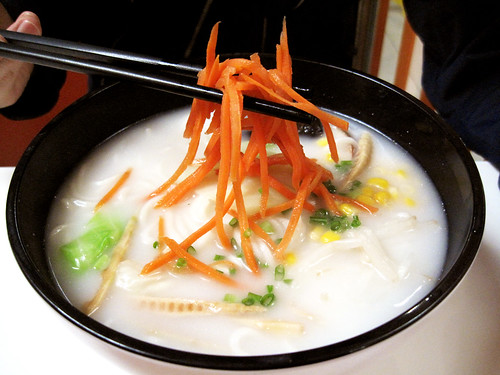

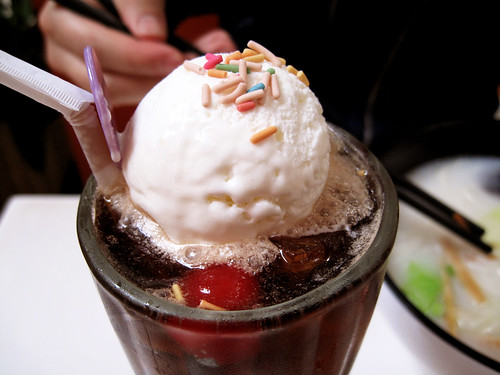












Nice to see some airports have decent food.
Asian airport food is absolutely legit… I know that Taipei Taoyuan International makes a mean bowl of beef noodle soup!
@someguy – Yeah, I hate having to get to the airport early in NY because the food always sucks.
@Nicholas – One day I have to get to Taipei. So many yummy places to explore!
Well if it’s ever during the Summer… 😀
[…] has the array of Asian food you’d expect, with just about every country represented. I had a nice Vietnamese fried rice from […]